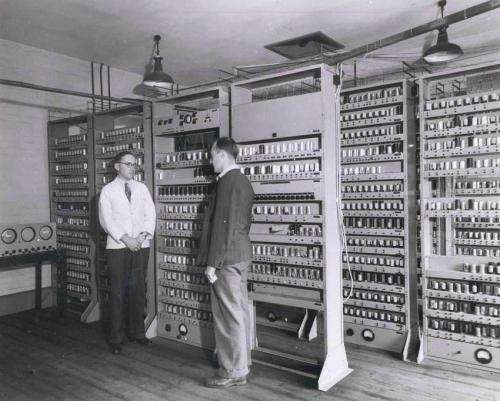June 30, 2014 weblog
Historic EDSAC circuit diagrams rescued from pile for trash

(Phys.org) —A discovery of diagrams is helping to reconstruct a historically significant computer, named EDSAC. Nineteen detailed circuit diagrams sitting in a corridor pile destined for the scrap heap were recently discovered, rescued, and handed over to a project team who are trying to achieve a historical milestone in better understanding the earlier history of computing. and gaining insights about how EDSAC was built and to get in tune with the EDSAC engineers' thinking. The EDSAC Replica Project aim is to build a working replica of this Cambridge University-built computer, which ran its first program in 1949, widely acknowledged as the world's first practical, general purpose computer. EDSAC stands for Electronic Delay Storage Automatic Calculator.
Andrew Herbert is leading the reconstruction project. He said the EDSAC is important as the first computer built for other people to use to solve real problems that previously had to be solved using hand calculators or paper and pencil methods. EDSAC made a dramatic difference in the speed in which they could do calculations. The pioneering computer, designed by Sir Maurice Wilkes, helped scientists analyze data. The EDSAC contained some 3000 valves arranged in 12 racks and consumed about 12Kw of power. While there had been special purpose computers before EDSAC, for example, for code-breaking and artillery shell calculations, EDSAC became known as the world's first general purpose computer.
The 19 large-scale detailed circuit diagrams for it that now have come to light show how EDSAC changed as it was put together and tested. For example, elements that were modified after the machine was up included redesigning the circuitry to get stronger signals and improvements to the instruction set and error correction in order to distinguish programming errors from machine malfunction. Cambridge News said the diagrams date from between 1949 and 1953. The rebuild project at the outset had relatively few plans to work with. The effort to create EDSAC left little information about how the original design changed as it was put together.
"Very few artefacts of EDSAC remain," said Herbert. "However, these papers give a clue as to why a few, such as a chassis, do exist." He added that "They are giving us some fascinating insights about how EDSAC was built and show that we are very much in tune with the original engineers: both teams have been exercised by the same concerns," according to BBC News.
The diagrams were to be thrown away, but once discovered were given to the EDSAC team at Bletchley Park. The discovery was made by a former engineer at Cambridge University's Mathematical Laboratory, said Cambridge News.
John Loker worked as an engineer in the University of Cambridge's mathematical laboratory in 1959, soon after EDSAC was turned off. Loker recently visited the National Museum of Computing and he learned about the reconstruction plan. He explained how he came across the drawings: "I started work as an engineer in the Maths Lab in 1959 just after EDSAC had been decommissioned. In a corridor there was a lot of stuff piled up ready to be thrown away, but amongst it I spotted a roll of circuit diagrams for EDSAC. I'm a collector, so I couldn't resist the urge to rescue them."
The project began in 2011; the reconstruction is due for completion in late 2015.
More information:
— www.bbc.com/news/technology-23079905
— www.bbc.com/news/technology-27995229
— www.edsac.org
© 2014 Tech Xplore




















